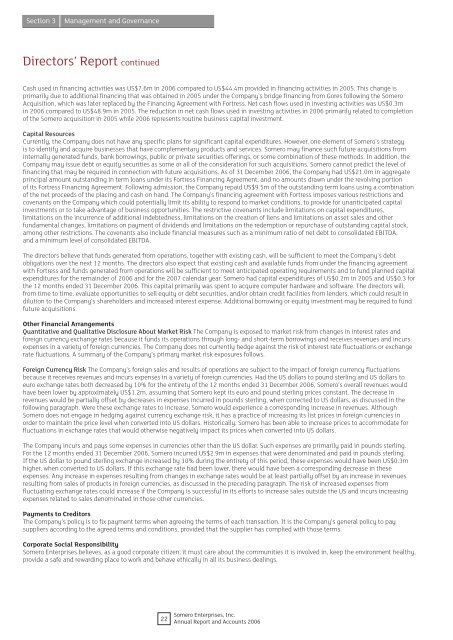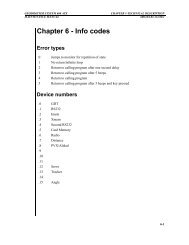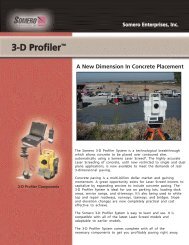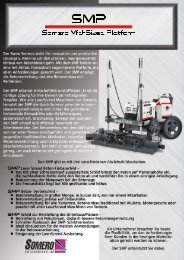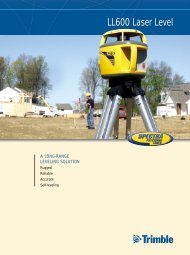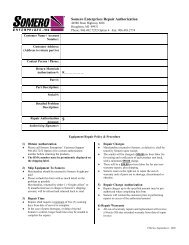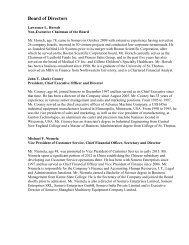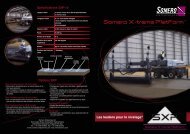PDF - Somero Enterprises
PDF - Somero Enterprises
PDF - Somero Enterprises
- No tags were found...
You also want an ePaper? Increase the reach of your titles
YUMPU automatically turns print PDFs into web optimized ePapers that Google loves.
Section 3Management and GovernanceDirectors’ Report continuedCash used in financing activities was US$7.6m in 2006 compared to US$44.4m provided in financing activities in 2005. This change isprimarily due to additional financing that was obtained in 2005 under the Company’s bridge financing from Gores following the <strong>Somero</strong>Acquisition, which was later replaced by the Financing Agreement with Fortress. Net cash flows used in investing activities was US$0.3min 2006 compared to US$48.9m in 2005. The reduction in net cash flows used in investing activities in 2006 primarily related to completionof the <strong>Somero</strong> acquisition in 2005 while 2006 represents routine business capital investment.Capital ResourcesCurrently, the Company does not have any specific plans for significant capital expenditures. However, one element of <strong>Somero</strong>’s strategyis to identify and acquire businesses that have complementary products and services. <strong>Somero</strong> may finance such future acquisitions frominternally generated funds, bank borrowings, public or private securities offerings, or some combination of these methods. In addition, theCompany may issue debt or equity securities as some or all of the consideration for such acquisitions. <strong>Somero</strong> cannot predict the level offinancing that may be required in connection with future acquisitions. As of 31 December 2006, the Company had US$21.0m in aggregateprincipal amount outstanding in term loans under its Fortress Financing Agreement, and no amounts drawn under the revolving portionof its Fortress Financing Agreement. Following admission, the Company repaid US$9.5m of the outstanding term loans using a combinationof the net proceeds of the placing and cash on hand. The Company’s financing agreement with Fortress imposes various restrictions andcovenants on the Company which could potentially limit its ability to respond to market conditions, to provide for unanticipated capitalinvestments or to take advantage of business opportunities. The restrictive covenants include limitations on capital expenditures,limitations on the incurrence of additional indebtedness, limitations on the creation of liens and limitations on asset sales and otherfundamental changes, limitations on payment of dividends and limitations on the redemption or repurchase of outstanding capital stock,among other restrictions. The covenants also include financial measures such as a minimum ratio of net debt to consolidated EBITDA,and a minimum level of consolidated EBITDA.The directors believe that funds generated from operations, together with existing cash, will be sufficient to meet the Company’s debtobligations over the next 12 months. The directors also expect that existing cash and available funds from under the financing agreementwith Fortress and funds generated from operations will be sufficient to meet anticipated operating requirements and to fund planned capitalexpenditures for the remainder of 2006 and for the 2007 calendar year. <strong>Somero</strong> had capital expenditures of US$0.2m in 2005 and US$0.3 forthe 12 months ended 31 December 2006. This capital primarily was spent to acquire computer hardware and software. The directors will,from time to time, evaluate opportunities to sell equity or debt securities, and/or obtain credit facilities from lenders, which could result indilution to the Company’s shareholders and increased interest expense. Additional borrowing or equity investment may be required to fundfuture acquisitions.Other Financial ArrangementsQuantitative and Qualitative Disclosure About Market Risk The Company is exposed to market risk from changes in interest rates andforeign currency exchange rates because it funds its operations through long- and short-term borrowings and receives revenues and incursexpenses in a variety of foreign currencies. The Company does not currently hedge against the risk of interest rate fluctuations or exchangerate fluctuations. A summary of the Company’s primary market risk exposures follows.Foreign Currency Risk The Company’s foreign sales and results of operations are subject to the impact of foreign currency fluctuationsbecause it receives revenues and incurs expenses in a variety of foreign currencies. Had the US dollars to pound sterling and US dollars toeuro exchange rates both decreased by 10% for the entirety of the 12 months ended 31 December 2006, <strong>Somero</strong>’s overall revenues wouldhave been lower by approximately US$1.2m, assuming that <strong>Somero</strong> kept its euro and pound sterling prices constant. The decrease inrevenues would be partially offset by decreases in expenses incurred in pounds sterling, when corrected to US dollars, as discussed in thefollowing paragraph. Were these exchange rates to increase, <strong>Somero</strong> would experience a corresponding increase in revenues. Although<strong>Somero</strong> does not engage in hedging against currency exchange risk, it has a practice of increasing its list prices in foreign currencies inorder to maintain the price level when converted into US dollars. Historically, <strong>Somero</strong> has been able to increase prices to accommodate forfluctuations in exchange rates that would otherwise negatively impact its prices when converted into US dollars.The Company incurs and pays some expenses in currencies other than the US dollar. Such expenses are primarily paid in pounds sterling.For the 12 months ended 31 December 2006, <strong>Somero</strong> incurred US$2.9m in expenses that were denominated and paid in pounds sterling.If the US dollar to pound sterling exchange increased by 10% during the entirety of this period, these expenses would have been US$0.3mhigher, when converted to US dollars. If this exchange rate had been lower, there would have been a corresponding decrease in theseexpenses. Any increase in expenses resulting from changes in exchange rates would be at least partially offset by an increase in revenuesresulting from sales of products in foreign currencies, as discussed in the preceding paragraph. The risk of increased expenses fromfluctuating exchange rates could increase if the Company is successful in its efforts to increase sales outside the US and incurs increasingexpenses related to sales denominated in those other currencies.Payments to CreditorsThe Company’s policy is to fix payment terms when agreeing the terms of each transaction. It is the Company’s general policy to paysuppliers according to the agreed terms and conditions, provided that the supplier has complied with those terms.Corporate Social Responsibility<strong>Somero</strong> <strong>Enterprises</strong> believes, as a good corporate citizen, it must care about the communities it is involved in, keep the environment healthy,provide a safe and rewarding place to work and behave ethically in all its business dealings.22<strong>Somero</strong> <strong>Enterprises</strong>, Inc.Annual Report and Accounts 2006


